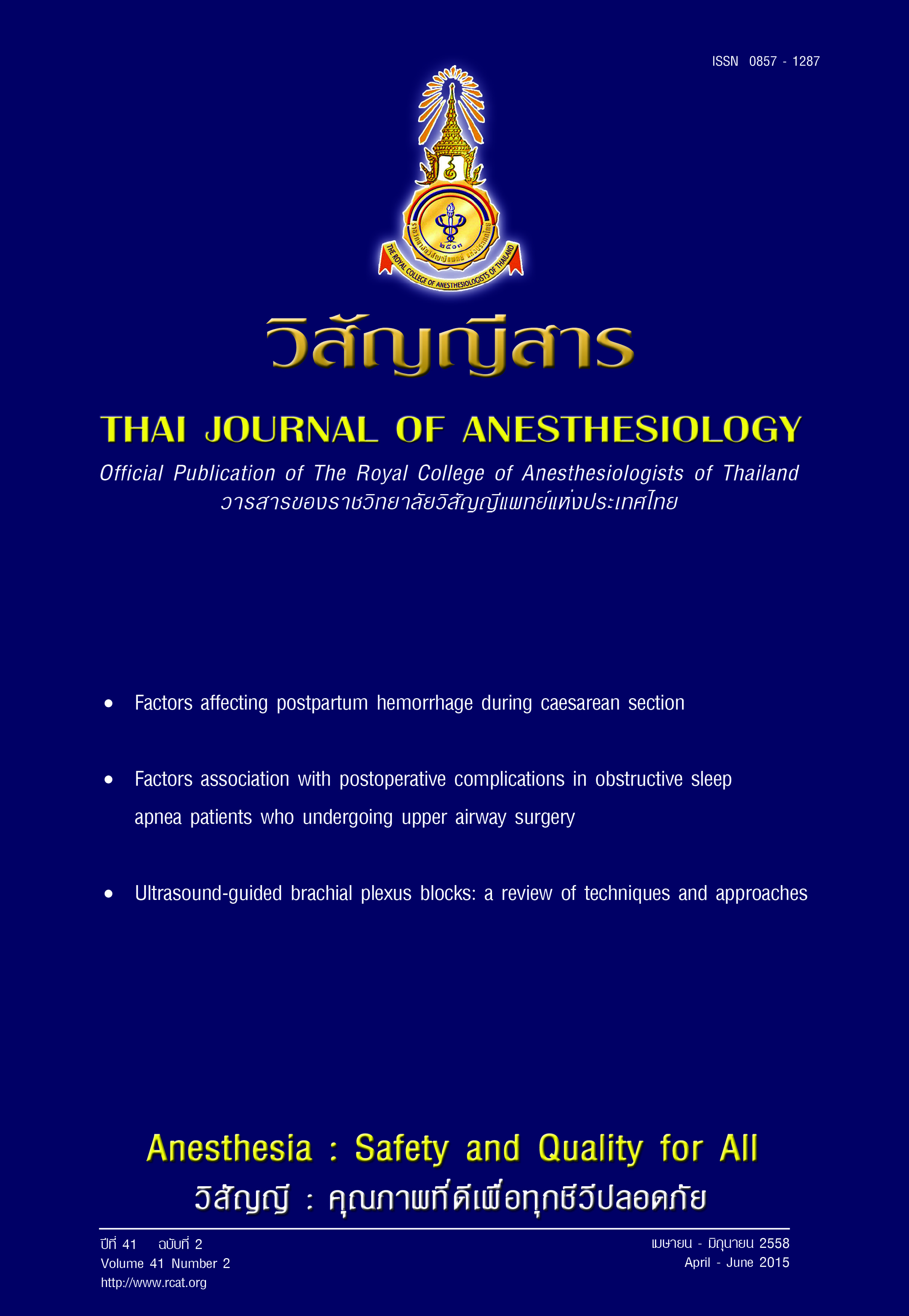Knowledge, anxiety and opinions of pre-operation patient watched anesthetic TV channel
Main Article Content
Abstract
Background: Patients give the most attention and recognize information from television (TV) station media. This study conducted an anesthesia TV channel to inform knowledge and understanding about anesthesia before surgery.
Methods: The anesthesia TV channel was made and broadcasted film for 24 hours at Queen Savang Vadhana Memorial Hospital, the Thai Red Cross Society. Also, the knowledge, anxiety and opinions questionnaire was created with a reliability of 0.92 by Cronbach’s Alpha. One hundred patients who agreed to answer the questionnaire was divided into 2 groups: 50 patients in each watched and unwatched anesthesia TV channel groups. The inclusion criteria were age 16-60 years old, never been anesthesied before or had been anesthesied more than 10 years ago, and 1 day before elective surgery. The statistic program was used to analyze data. The descriptive statistics were percentage, mean and standard deviation (SD). Chi-square (X2) was used to compare the differences of numbers and percentages between two groups. Statistically significant differences level was determined as p less than 0.05.
Results: The group that watched anesthesia TV channel had knowledge about “removing dentures before surgery strictly” more than the group that did not watch the anesthesia TV channel with statistically significant differences (100.0% vs. 88.0%, p = 0.012). After watching anesthesia TV channel, the patients’ anxieties were decreased with statistically significant differences (p < 0.001). Patients with moderate and severe anxiety was decreased from 50.0% and 38.0% before watching anesthesia TV channel to 26.0% and 26.0% after watching anesthesia TV channel, respectively. In patient’s opinion, the anesthesia TV channel enhanced their knowledge and practice before receiving the anesthesia for surgery.
ความรู้ ความวิตกกังวลและความคิดเห็นก่อนการระงับความรู้สึกเพื่อทำผ่าตัดของผู้ป่วย ที่ดูสื่อสถานีโทรทัศน์วิสัญญี
บทนำ: สถานีโทรทัศน์ เป็นสื่อที่ผู้ป่วยให้ความสนใจและมีผลต่อการรับรู้ข้อมูลมากที่สุด การศึกษานี้ได้ จัดทำสถานีโทรทัศน์วิสัญญี เพื่อให้ความรู้และความเข้าใจเกี่ยวกับการระงับความรู้สึกกับผู้ป่วยก่อนการผ่าตัด
วิธีการศึกษา: ผู้ศึกษาจัดทำสื่อสถานีโทรทัศน์วิสัญญี ถ่ายทอดภาพยนตร์ตลอด 24 ชั่วโมง ภายในโรงพยาบาล สมเด็จพระบรมราชเทวี ณ ศรีราชา สภากาชาดไทย และจัดทำแบบสอบถามเกี่ยวกับความรู้ความวิ ตกกังวลและ ความคิดเห็นเกี่ยวกับสื่อสถานีโทรทัศน์วิสัญญี ที่ได้รับการตรวจสอบความตรงเนื้อหาโดยวิสัญญีแพทย์และ วิสัญญีพยาบาลและมีค่าความเที่ยงโดยมีสัมประสิทธิ์แอลฟาของครอนบาคเท่ากับ 0.92 กลุ่มตัวอย่างเป็นผู้ป่วย ที่สมัครใจในการตอบแบบสอบถาม 100 ราย แบ่งเป็น 2 กลุ่ม คือ กลุ่มที่ดูสื่อโทรทัศน์วิสัญญี 50 ราย และกลุ่ม ที่ไม่ได้ดูสื่อโทรทัศน์วิสัญญี 50 ราย โดยมีเกณฑ์การคัดเลือกกลุ่มตัวอย่างที่ตอบแบบสอบถาม ประกอบด้วย เป็นผู้ป่วยที่อายุ 16-60 ปี ไม่เคยผ่านการระงับความรู้สึกใดๆ มาก่อนหรือเคยผ่านการระงับความรู้สึกมามากกว่า 10 ปี และเป็นผู้ป่วยผ่าตัดแบบไม่เร่งด่วนที่กำหนดก่อนวันผ่าตัด 1 วัน วิเคราะห์ข้อมูลโดยใช้โปรแกรมสถิติ โดยสถิติแบบบรรยายใช้ร้อยละ ค่าเฉลี่ยและส่วนเบี่ยงเบนมาตรฐาน ส่วนสถิติเปรียบเทียบความแตกต่างของ จำนวนและร้อยละระหว่างสองกลุ่มใช้ไคสแคว์ กำหนดค่าความมีนัยสำคัญทางสถิติที่ระดับ p < 0.05
ผลการศึกษา: กลุ่มที่ดูสื่อโทรทัศน์วิสัญญี มีความรู้เกี่ยวกับ “การถอดฟันปลอมก่อนการผ่าตัดอย่างเคร่งครัด” มากกว่ากลุ่มที่ไม่ได้ดูสื่อโทรทัศน์วิสัญญีอย่างมีนัยสำคัญทางสถิติ (100.0% vs. 88.0%, p = 0.012) หลังการชม สื่อโทรทัศน์วิสัญญี ผู้ป่วยมีความวิตกกังวลลดลง โดยแตกต่างกันอย่างมีนัยสำคัญทางสถิติ (p < 0.001) ผู้ป่วย ที่มีความวิตกกังวลระดับปานกลางและระดับมาก ก่อนการชมสื่อโทรทัศน์วิสัญญี มีร้อยละ 50.0 และ 38.0 หลังการชมสื่อโทรทัศน์ วิสัญญี มี ความวิตกกังวลลดลงเป็นร้อยละ 26.0 และ 26.0 ตามลำดับผู้ป่วยมีความคิดเห็น ว่าสื่อโทรทัศน์วิสัญญีทำให้มีความรู้เกี่ยวกับการเตรียมความพร้อมและมีการปฏิบัติตัวก่อนการให้การระงับ ความรู้สึกเพื่อทำผ่าตัดได


